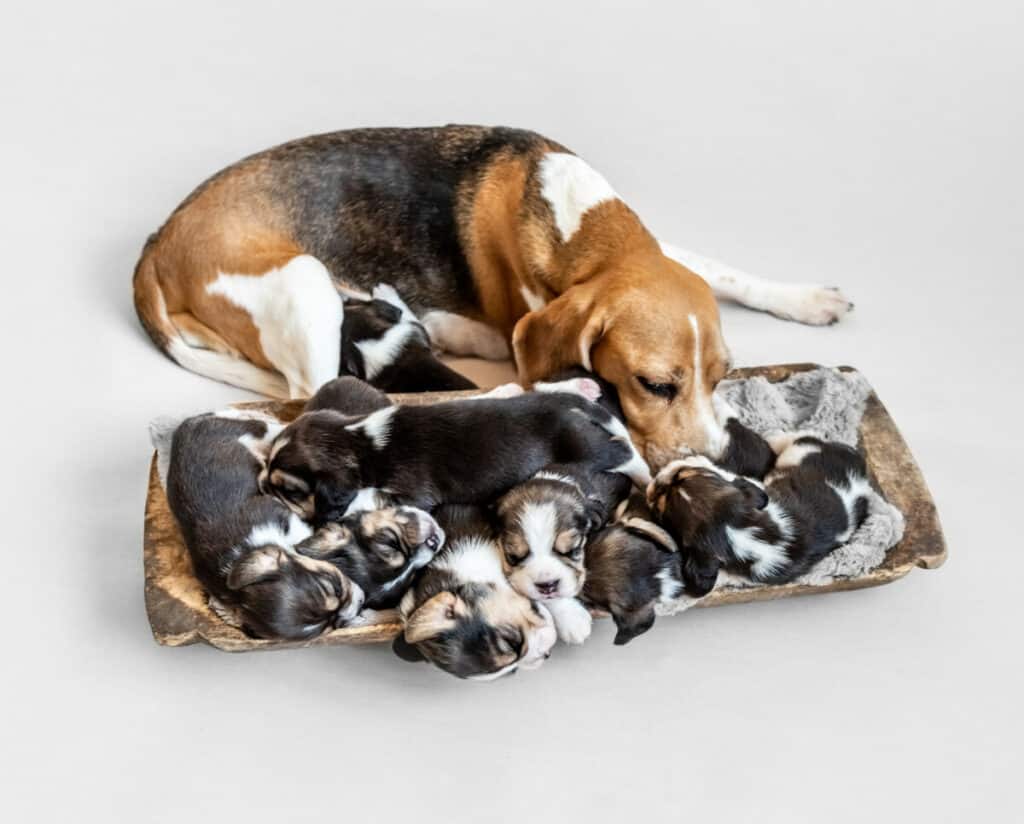
Everybody loves puppies! But is it possible to tailor the gender of a batch of puppies just for you?
To get more female puppies in a litter, feed the mother a diet that is high in acidity two to three weeks before conception. The higher acidity in the mother’s reproductive cycle will increase the number of female puppies in their next litter.
Taking good care of your mother dog doesn't mean there's nothing you can do to influence the litter. You actually have more control than you might think.
What Determines The Sex of a Puppy?
The sex of a puppy is actually decided mostly by the dad. Sperm either carry the genetic material for a male or female. This is determined by the chromosome the sperm has.
Chromosomes are pieces of DNA. The chromosomes for gender are referred to as X and Y chromosomes. Everybody has at least one X chromosome. Males have a Y chromosome as well, while females have two X chromosomes.
There isn’t anything you can do to make a male produce more sperm with X chromosomes. However, there are some things you can do to a female.
Females don’t determine the sex of a puppy, but their bodies can be more habitable for male or female sperm.
Scientific study has shown that when a mother’s body is more acidic, it produces more females. The acidity kills off male sperm while allowing female sperm to fertilize the mother.
Some breeders increase acidity in a mother by swabbing the vagina with vinegar prior to breeding to increase her acidity. It’s not totally determined if this produces more females or just kills potential males that would have been born.
For example, if this is attempted and the mother gives birth to six females, did the vinegar swab give her more females, or would she have had six either way? Did the swab prevent an additional three male puppies from being born?
Recent studies are more supportive of a more indirect method: feeding the mother a more acidic diet a few weeks prior to mating to increase her acidity more naturally to produce more females.
Likewise, a more alkaline diet can encourage a higher yield of male puppies.
What Determines the Size of a Litter?

Litter size can depend on a few factors that are out of your control, like the breed of the dog and how old the mother is. But there are some things you can control.
Healthy mothers give birth to more puppies. Take the mother in for regular checkups prior to breeding, give her frequent exercise, and feed her a healthy diet high in protein and vitamins.
Females will generally have smaller litter the first couple of times that she gives birth. They will have larger litters later, then smaller ones as they grow older.
Small dogs will have smaller litters than big dogs. Larger batches of puppies will have shorter gestation periods than smaller batches.
Puppies conceived in the winter and born in the summer will have larger litter sizes than puppies conceived in the summer and born in the winter. This is likely because the summer provides more food for the mother, which allows her to easily take care of more puppies.
Despite being domesticated, the seasons still have a large impact on dogs and their mating cycles! None of these factors, however, have been observed to impact the gender of the puppies, which is determined by other aspects.
Females should also be treated well prior to mating, as stress on the mother can negatively affect the puppies.
How Can you Prepare a Female Dog for Healthy Litter?

One of the best things you can do for your dog is to make sure she’s healthy when the puppies come! Make sure the mother has plenty of food and water and that her meals are especially high in protein, which is important for any expecting mother. You should also have a designated space for the mother and her puppies that’s warm and comfortable.
You can use a whelping box or any easily cleaned space that the mother can escape, but not the puppies. You should let the mother see the box and spend some time in it before the birth so she’s already used to it. Check her weight occasionally, as she should be gaining weight regularly. If the mother isn’t getting heavier, take her to a vet!
You should shorten walks and do other exercises as well, especially during the last few weeks of the mother’s pregnancy. Too much exercise can be bad for a heavily pregnant dog. When the puppies are born, make sure each one is crying.
If a puppy isn’t crying when it’s born, rub it with a clean towel until it starts to. The crying indicates that the puppy’s lungs are clear and they can breathe. The mother should naturally clean up the placental membrane around each puppy and cut the umbilical cord with her teeth, but if she doesn’t, you will have to do so. Keep everything around the newborn puppies clean and warm at all times.
The mother should still be eating a highly nutritious diet and drinking lots of water following the birth of the puppies so she can healthily nurse them. If any of the puppies aren’t able to nurse on their own, you might have to bottle feed them to make sure they’re getting all the nutrition they need.
Check in with a vet during all the stages of whelping, even if it seems like everything is fine. You want the mother and her puppies to be as healthy as possible!
Can Litter be All Male or All Female?
The male to female ratio of a puppy litter can depend on the size of the litter and the mother's diet, but for the most part, it's random. A puppy litter can be born all male or all female, but the odds are slim, especially if the litter is large.
The puppies' gender is, for the most part, a fifty-fifty chance of male or female. While it's certainly possible for you to get a little of all males or females, don't plan on it, as the odds are slim.

Cindy is a prolific writer and online researcher who can't imagine life without dogs. There is scarcely a dog topic she has not researched or written about. Her love for dogs and helping dog parents is evident by the thousands of dogtemperament.com visitors who read her articles monthly. Most of all, each topic Cindy writes on helps forge a stronger bond and understanding between her and her happy Catahoula Leopard Dog Jossie.